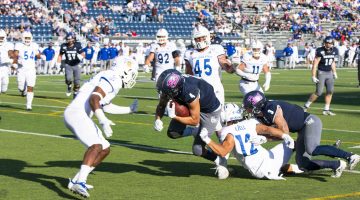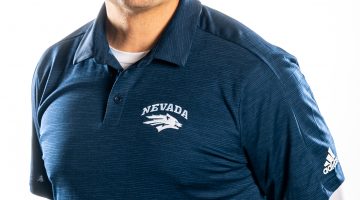
Virtual reality—more commonly known as VR—has grown leaps in bounds in just a few short years. Once thought to be just science fiction, modern technology has created an opportunity for VR to become a tool for users around the world.
Currently, VR is used in a wide range of applications, from medical training to video games. VAR, a VR technology company, has changed the public perception of what was previously thought possible in regard to VR’s capabilities. One way they’re doing that, is integrating it on the football field.
VAR was created by football coach A.J. Smith. Smith currently is an offensive assistant coach for the Houston Roughnecks, Houston’s XFL team. Previously, Smith worked as the quarterbacks coach at Jackson State University.
When Jay Norvell took over as head football coach at Nevada in 2017, he brought with him more than just a change in coaching philosophy, he changed the way Nevada football prepares their quarterbacks. He brought with him, VAR.
Offensive assistant, Clayton Webb, is the VR guru of Nevada football. When he came onto the staff in 2018, he brought with him years of experience with the technology.
Before Nevada, Webb played and coached at Bellhaven University in Jackson, Miss. Webb played under—and worked for—legendary football coach, Hal Mumme. Mumme was on the architects of the ‘Air Raid’ offense, an offensive football scheme used at countless universities around the country. Mumme is the father of Nevada football’s current offensive coordinator, Matt Mumme.
Webb’s experience with the technology has allowed for coaching to come at a rampant pace. Gone are the days when a coach becomes an ‘armchair quarterback’, at least according to Webb.
“As quarterbacks, why it’s so good for us, is that at times you get the armchair quarterback coach,” Webb said. “He says, why didn’t you see this, why didn’t you do this, why weren’t your eyes here? Now, we’re getting more accurate mental reps with this….It’s basically as if I’m in there.”
The VAR system is actually rather uncomplicated in its design. The controllers and headset are from an HTC Vive kit. The HTC Vive is a modern VR kit that can be purchased at most electronic stores. What makes the VAR system unique, is the software and camera that comes with the complete package. The headset, controllers, software and camera is sold as one kit. However, upgrades can be purchased, such as better cameras and more advanced software.
The camera that Nevada football uses, is what is commonly referred to as a 360-degree camera.
“We have what we call a 360-degree camera, you hold it about four to five yards behind the quarterback,” Webb said. “Once we take that camera footage, and we plug it into the computer, we can turn it into watchable footage on these goggles.”
The camera has lenses on both sides of it. The camera takes one photo of each side—or video—and the corresponding software combines the footage into one concurrent image.
Webb stresses that reps in practice and live game situations are still the best way for a quarterback to learn and get experience. However, compared to studying traditional game film, VAR is the superior option.
“You get all the reps, you get to see all the plays, you get to make all the reads, you get to do the footwork in here,” Webb said. “The only thing you didn’t get to do that day, was get to throw the football.”
Nevada currently has seven quarterbacks on the roster. Getting all of them consistent practice reps is nearly impossible. However, through VAR, this is a thing of the past.
When the program was first brought on campus, the starting quarterback was Ty Gangi. Gangi has since graduated and moved on from the program. Webb admitted that because of Gangi’s status as a starter, he spent little time in the VR lab.
This year, the quarterback position has been a little up in the air. Through the first three games of the season, redshirt freshman Carson Strong led the Pack. This was partially due to preseason starter, senior Cristian Solano, going down with a hand injury before the season.
Since the game against UTEP—week four—Nevada has gone through a quarterback carousel. Strong, Solano and Malik Henry have all seen the field for at least a drive. It just so happens to be, that all three of these quarterbacks have spent ample time training in the VR lab, though in some different ways.
VR can cause motion sickness in some people. According to Webb, Solano is one of them. However, he still grinds out his reps in the lab, be it in just five-minute session so he doesn’t get sick. On the other hand, there’s Strong. According to the former Belhaven quarterback, Strong can be under the goggles for upwards of 30 minutes at a time. He likes to grind out his session all at once.
Currently, the version of VAR that Nevada football uses is limited to what is recorded through the 360-degree camera. Recently, VAR came out with an upgraded system that allows for holograms to be uploaded into the VR headset. This allows for athletes that are training with it to be tested in ever-changing scenarios, not just prerecorded ones.
For now, Webb is happy to work with what is being provided.
“It’s become a really good teaching tool for all the quarterbacks, and I enjoy doing it because you can see it change for them and how they see it,” Webb said. “So I get to coach them easier because I get to see exactly what they’re seeing.”
Ryan Freeberg can be reached at rfreeberg@sagebrush.unr.edu and on Twitter @SagebrushSports












